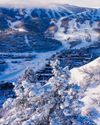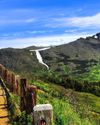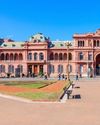
Today it’s hard to imagine this lush park as a former bastion: Ornate staircases shaded by mature trees lead through a vertical greenspace filled with sculptures, fountains, chapels and dramatic overlooks.
The hill isn’t the only thing that’s changed. Beyond the ancient church spires and broad plazas of the historic center, Santiago’s outward development spans a shining sea of skyscrapers spreading nearly to the mountains and including Latin America’s tallest building.
According to the World Economic Forum, Chile is not only Latin America’s most competitive nation, but — thanks largely to exports of minerals, wood, fruit, seafood and wine — it also boasts South America’s highest gross domestic product. The country also remains one of the United States’ strongest partners in Latin America and a leader in promoting respect for the rule of law, economic stability, education, environmental protection, human rights and sustainable development.
This story is from the January/February 2022 edition of Global Traveler.
Start your 7-day Magzter GOLD free trial to access thousands of curated premium stories, and 8,500+ magazines and newspapers.
Already a subscriber ? Sign In
This story is from the January/February 2022 edition of Global Traveler.
Start your 7-day Magzter GOLD free trial to access thousands of curated premium stories, and 8,500+ magazines and newspapers.
Already a subscriber? Sign In

Nurturing Nature
Connect with the abundant flora and fauna of Belize.

Sojourn by the Sea
Discover plenty to smile about in Thailand’s exotic islands.

Colorado Dreaming
For family ski fun, Snowmass and Beaver Creek steal the show.

The Great Outdoors
Anchorage opens the door to all that is wild in Alaska.

Buenos Aires on Foot
Hit the highlights with online itineraries and the city’s free app.

Above and Beyond
Global Traveler celebrates the 2021 winners of the GT Tested Reader Survey awards.

Wellness Wonderland
Reboot at Lake Austin Spa Resort in Texas Hill Country.

Good Vibes
Adelaide’s West End thrives as a hip urban hub close to nature.

Solo Voyages
Cruise lines adapt policies to accommodate those traveling alone.

Grand Slam
Follow the pro tennis tour around the world.